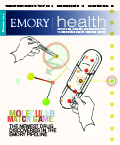"Show me the numbers"

At the Emory/Georgia Tech Center for Health Discovery and Well-being, health partners are gathering data on what makes people healthier and happier. This interview by editor Rhonda Mullen with the center’s director, Ken Brigham, reveals what they are finding.
Q) In your paper, “Predictive Health: The Imminent Revolution in Health Care,” you describe America as having a “disease care non-system” rather than a health care system. What do you mean by that?
A) I first heard that description from Jim Curran, dean of the Rollins School of Public Health at Emory, and I think it so accurately describes how we in the United States approach medical care. Our system is disease-focused. Rather than health care, it is medical care. People enter the system only when they have disease. We have well baby clinics but no well adult clinics.
And it is a non-system because there is not one system but rather multiple systems that tend to operate in silos. A good example is the electronic medical record (EMR). Every health system has developed its own EMR, but it tends to work only in that system. It is not portable. Even some big systems like the VA, which does a tremendously good job on EMRs, isn’t compatible with the EMRs from another governmental agency that provides care for a specialized segment of the armed forces. That’s just one example of how Balkanized the whole non-system of medical care is.
Q) What does the predictive health approach involve?
A) We’re saying focus on people while they are healthy. But first we have to define health. What about the distinction between health and exemplary health? What is different about people who are healthy, bright, and creative as opposed to people who can’t be diagnosed with a disease but who just aren’t as healthy as they ought to be?
The other premise is that if we provide people with information about their health and then give them support in figuring out what they are going to do to improve their health and the tools to make it happen, it will have a positive impact.
|
"We pay too much for health care, close to twice what most other developed countries pay, says Ken Brigham. Enter predictive health, with a fundamental premise that keeping people healthy should be cheaper and more efficient and have a greater return on investment than simply waiting for disease to happen before we intervene." |
Q) What happens at the center?
A) The center is under the umbrella of Emory’s Predictive Health Institute. I like to call it the demonstration model or predictive health in action.
When participants come here, they are introduced to a health partner, who stays with them through their whole experience. The health partners are a different kind of health professional. They are not doctors, nurses, or nurse practitioners, but they hold bachelor’s or master’s degrees and have completed an intensive curriculum in health-focused care and health coaching.
Participants fill out a number of computer-based questionnaires and surveys about their health. We next take a number of measures, including body composition, blood pressure, and pulse, and we collect blood and urine samples. We also look at bone density with a Decatron and cardiovascular fitness as measured on a treadmill.
At the end of the process, the participants sit down with their health partners to go over their health assessment. The 40-page report comes with a dashboard that summarizes all the information in a way that is easy to understand. The health partner combs through the report and identifies areas and opportunities.
The participants themselves drive the health action plan. Once they’ve made their own goals, the health partner helps them figure out how to get there and what is realistic.
Q) You’ve talked about the need for a horizontal approach to health. What does that mean?
A) A vertical relationship is what you’ve probably experienced with your doctor, where the doctor is the authority figure and tells you what to do. But we know that doesn’t work because 30% of the prescriptions written by doctors are never filled. And according to numerous studies, half of the people who see doctors don’t do what the doctors told them to do. Part of the problem is communication because they didn’t understand what the doctor told them. But it’s more than that. Even if people understand what to do, they don’t do it.
Just being told what to do in a one-time encounter, doesn’t change people’s behavior—even when the person is sick. This authoritative proscriptive approach to health doesn’t work.
By contrast, the horizontal relationship or partnership idea is that we are on the participant’s side. The health partners are not judgmental or punitive. Their goal is to engage people, educate them in the sense that we tell them more about their health than they ever knew before, and empower them to help them figure out to do what they want to do. We then promote and support them on the way to their goals and observe their outcomes.
|
"We can’t keep doing what we’re doing because we’re going broke doing it. And we are not healthier as a population than other countries that spend a lot less money on health care. We need hard data. Is this approach cost-effective? What could we do differently that could work as well that might be cheaper?" |
Q) Can you describe the research the center is doing and what you’ve discovered so far?
A) Part of what we’re learning comes from a cohort of healthy Emory employees who were drawn from a random sample. We describe them as “essentially healthy” because it turns out they do have some things that are wrong with their health. Our data includes a whole battery of questions that doesn’t just include physical health but also mental health, social supports, sleep patterns, quality-of-life measures, and spirituality.
If you look at the cohort as a whole, the partnership seems to work. We’ve measured improvements in physical health, and they’ve been accompanied by improvements in well-being, quality of life, depression, and stress.
We’re also collaborating on a study on healthy aging with a different cohort. Most clinical studies in older adults have focused on disease or injury (what can go wrong). There is little detailed information that defines optimal health (what can go right) as a function of aging.
Arshed Quyyumi in cardiology has gathered information on close to 300 people who are exceptionally healthy and range in age from 20 to 80. They have normal blood pressure and normal body mass index, take no medications, and have no known diagnosed disease. He has looked at many of the same things that we are measuring on our essentially healthy people in relationship to age. We are comparing our people with his people.
What we’ve found so far is that a lot of things change with age, no matter how healthy you are. For example, one of the measurements of vascular disease is the thickness of the carotid artery in your neck. That goes up with age, no matter your state of health. If you take our 700 people, the slope of the line is steeper, indicating that their arteries get thicker at a faster rate than those of the exceptionally healthy group. What we don’t yet know is, if people change their behaviors, can that trigger a switch to the lower sloped line.
Q) Can the model followed at the center translate to the broader society?
A) I think it will. In fact, the basic concept has to. We can’t keep doing what we’re doing because we’re going broke doing it. And we are not healthier as a population than other countries that spend a lot less money on health care.
More to the point, the question is, is this model scalable? It is probably not as it exists here because much of what we are doing is research-based. But I think what we learn from these studies will show us what is most valuable and what works best.
Q) What is the next step in making a change from a disease to a health model?
A) You have to sell the idea to someone who will pay for it. We’re talking with self-insured employers, trying to partner with them in pilot studies to demonstrate what can be done. If we talk to HR people, their first question is, how much money will it save me next year? If I say to Peter Barnes [director of Emory Human Resources]—“Look at how much healthier and happier your employees are. Statistically speaking, they must be better employees,” his response is, “Show me the numbers.”
We need hard data, and our collaborator Bill Rouse at Georgia Tech is helping us get those numbers. He is taking the whole center experience and doing an in-depth analysis of economic models related to the approach. Is it cost effective? What could we do differently that could work as well that might be cheaper? He also is chairing an Institute of Medicine subcommittee that is using data from the center as a model basis for a national discussion.
In the end, we have to figure out how to put a dollar value on well-being and other things that we believe are important in defining health.—EH
|
Web Connection: To learn more about the center’s approach to health, visit emoryhealthdiscovery.com. |
||||




